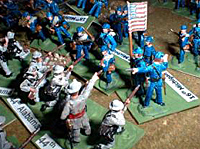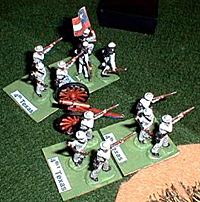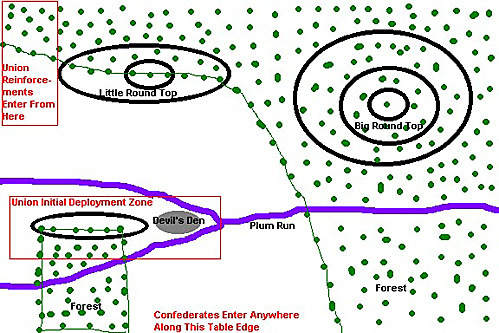 In February the history club studied the Civil War, focusing
on the crucial battle at Gettysburg. The students refought the
pivotal second day of the battle when the Confederates attacked
the boulder-strewn area known as Devil's Den and the hill named
Little Round Top. The Rebel attack was stopped, barely, by the
Union in an action that made Joshua Chamberlain a hero. Could
the students change history?
In February the history club studied the Civil War, focusing
on the crucial battle at Gettysburg. The students refought the
pivotal second day of the battle when the Confederates attacked
the boulder-strewn area known as Devil's Den and the hill named
Little Round Top. The Rebel attack was stopped, barely, by the
Union in an action that made Joshua Chamberlain a hero. Could
the students change history?
The first battle was very exciting. The Rebel plan was a clever one. The girl commanding one Confederate regiment launched a pinning attack on Devil's Den and the left end of the Union defensive line while another commander tried to turn the flank with his brigade. The Union responded immediately by moving the reserve regiments to intercept the flanking maneuver and shifting the Union right flank to bolster the left. The Union sharpshooters took up defensive positions among the rocks and boulders in Devil's Den.
 The Confederates saw an opportunity and brought in their third
brigade. They raced for the hole that had opened on the Union
right. The Union sacrificed a regiment to slow them down, buying
enough time to deploy an artillery battery in the gap. The 4th
Texas captured the cannons after suffering heavy losses. Meanwhile
the Confederates watched as two of their regiments were wiped
out trying to take Devil's Den with bayonet charges. They finally
took the position with the 15th Alabama by flanking it and charging
it from two directions. The main Confederate flanking maneuver
tried to push past the Union infantry. The Blue Coats poured withering
musket fire into the Rebel columns as they raced past.
The Confederates saw an opportunity and brought in their third
brigade. They raced for the hole that had opened on the Union
right. The Union sacrificed a regiment to slow them down, buying
enough time to deploy an artillery battery in the gap. The 4th
Texas captured the cannons after suffering heavy losses. Meanwhile
the Confederates watched as two of their regiments were wiped
out trying to take Devil's Den with bayonet charges. They finally
took the position with the 15th Alabama by flanking it and charging
it from two directions. The main Confederate flanking maneuver
tried to push past the Union infantry. The Blue Coats poured withering
musket fire into the Rebel columns as they raced past.
The Union reinforcements came charging onto the scene. Joshua Chamberlain and the 20th Maine were sent to recapture the cannons and stabilize the right flank. The Confederates managed to get 150 men from the 20th Georgia onto Little Round Top but their victory was short lived. The 83rd Pennsylvania, led by General Strong Vincent, drove off the rebels at bayonet point, sealing the Union victory.
In our second battle the Confederate commanders sent all their regiments on a wide flanking maneuver. Their timid attack was a dismal failure and the Union scored a relatively easy victory. Hopefully next time the commanders will be more aggressive. Robert E. Lee would not have been pleased.Fast and Easy Rules for Replaying Part of the Battle of Gettysburg
Introduction:
These rules were written for my History Club, a group of middle school students at Crest Memorial School in Wildwood Crest, NJ. The scenario takes place on the second day of Gettysburg. The Confederates attacked the left flank of the Union lines. After fierce fighting in and around the rocky area known as Devil's Den they had a chance to capture Little Round Top. However Union reinforcements, including Joshua Chamberlain's 20th Maine, arrived in time to stop them.
Turn Sequence:
1. Charge Moves
2. Confederate Normal Move
3. Union Normal Move
4. Confederate Fire
5. Union Fire
6. Melees
Charge Movement: A unit may not declare a charge unless it can contact an enemy unit with a charge move. A player may measure to see if a unit is within charge range. One enemy unit must be chosen as the target of the charge. A unit that wishes to charge must be in line formation and must pass a morale check first. Roll one die. If the check fails then the unit must stand in place during this turn. If the roll is less than or equal to the number of stands then the unit may charge. Move the charging unit into contact with the target of its charge. The unit being charged must now check morale. If it passes then it will be able to fire at the charging unit at point black range during its Fire Phase. If it fails its morale check it immediately moves 12" directly back, facing away from the enemy, and one stand is removed.
Normal Movement: Units may move the following distances:
Infantry Line: 6"
Infantry charging in line: 9"
Infantry Column: 12"
Limbered Artillery: 12"
Unlimbered Artillery: 0", but may change facing
A unit's movement is reduced by 3" if it crosses a stream
or hill during the turn or if it changes formation (including
artillery that limbers or unlimbers. Only one formation change
is allowed during a turn. An about face maneuver costs 3"
of movement.
Fire: Units that have not moved this turn may fire.
Range is measured from the center of a unit to the nearest part
of the target unit. Units may only fire to the front. Units in
column may only fire one stand. Roll one die per stand or gun
model. The chart indicates the number needed for a hit. Remove
one stand for each hit rolled by the firing unit. It takes two
hits in a turn to remove an artillery stand.
| Range | 1" | 6" |
| Infantry | 5-6 | 6 |
| Sharpshooters | 5-6 | 5-6 |
| Range | 1" | 6" | 12" |
| Artillery | 4-6 | 5-6 | 6 |
Hits are doubled if the target unit is in column or is enfiladed. Targets in cover get saving throws. Roll one die for each hit. Ignore the hit if the roll is a 6 in woods, or a 5 or 6 in Devil's Den. Any unit that loses a stand must take a morale check. You may not shoot into a melee.
Morale Checks:
Roll one die for each unit that has lost a stand. If the roll
is less than or equal to the number of stands then the unit passes.
Each artillery stand has a morale of four. If the roll is greater
than the number of stands then the unit has failed morale. It
immediately moves 12" backwards, facing away from the enemy,
and one stand is removed. Artillery that fails a morale check
while unlimbered will abandon the guns.
Melee: Each unit in the melee rolls one die. Modify the roll as follows:
Has More Stands than the enemy: +1
Confederates Charging: +1
Terrain Advantage (higher ground, in cover, etc.): +1
Officer attached: +1
Hitting the flank or rear: +1
Highest modified roll wins. The loser immediately loses a stand and retreats 6", facing the enemy. The winner may occupy the enemy position. If the roll is a tie then each side loses a stand and you roll again.
Officers: Each Brigade Commander is represented on the table. A Brigade Commander may attach himself to one of his units. This unit gets a +1 bonus on all melee rolls and the officer counts as a stand when testing morale. Every time a unit with an attached officer loses one or more stands due to enemy fire, or is engaged in a melee (win or lose) roll one die. If the roll is a 6 the officer is a casualty and is removed from player. All the units in his brigade must make an immediate morale check. The units in his brigade may not move, fire, or charge during their next turn. They may act normally on all subsequent turns. Special Case: Joshua Chamberlain is treated as an exceptional Regimental Commander. He must be attached to the 20th Maine at all times. He counts as a stand when performing morale checks, and adds +1 to melee rolls, just like a Brigade Commander. He is subject to the same officer casualty rules as an attached Brigade Commander, with the same consequences to his regiment if he is a casualty.
Victory Conditions: The side that controls Little Round Top at the end of the game is the winner.
Building the Armies: I decided to go with cheap 1/72 scale plastic figures for this game. The children tend to be rough on the figures, so it would be a waste to spend a lot of time and money on metal miniatures. The 1/72-scale figures are large enough for the kids to handle easily. Five boxes of Imex Union and Confederate Infantry ($10) and one box of Imex Union and Confederate Artillery ($5) provided all the figures I needed. You can find these boxes at a discount of 20% or more if you shop around.
I used my quick and easy method of painting 1/72 plastic figures. First they went in the dishwasher, still attached to their sprues. Then I cut the sprues apart, leaving the figures attached. A coat of white spray paint followed by a coat of blue or gray came next. I painted the skin, shoes, guns, and packs. The uniforms for the sharpshooters were painted green. I also painted one unit as Zouaves by giving them red hats and pants.
After sealing the figures (a futile endeavor) I finished them with a dose of Testor's Dull Cote. I removed the figures from their sprues and glued them onto squares of thin cardboard (cut from the boxes the figures came in). Three figures were put on each stand, with the commanders based individually. The bases were painted green to match the felt on the gaming table. Each stand was then given a ID label using computer generated mailing labels. The labels were color coded by regiment using colored pencils. Each regiment includes a figure carrying a flag. My flags came from Warflag (www.warflag.com). The flagstaffs were made from paperclips.
Historical Outcome:
The Confederate attack on Devil's Den and Little Round Top was the subject of considerable controversy. It began late in the day and was marked by confusion and a general lack of coordination. The terrain was partly responsible for this. Law's Brigade, with belated support from Robertson's Brigade, fought Ward's Brigade in and around Devil's Den. The fighting was fierce. The Confederates eventually drove the Union away but the timely arrival of the 40th NY prevented them from exploiting their success.
Benning's Brigade maneuvered to attack Little Round Top from the flank. By the time they arrived Vincent and Weed had arrived to defend the crucial position. Oates' 15th Alabama was given the difficult task of assaulting up the hill. They ran into Chamberlain's 20th Maine, which was defending the far left flank of the Union army. Several charges were turned back. Finally, with his men low on ammunition, Chamberlain ordered a bayonet charge, which finished off the weary confederates.
The Confederate's failure to take Little Round Top set in motion the famous events of the next day. Lee ordered a frontal assault on the Union center. Pickett's charge would go down in history as a bloodbath of legendary proportions. The Union stopped the attack, inflicting horrendous casualties on the Confederates.
The Map:
I started by making the map entirely out of felt. Green was used for the main tablecloth, blue for the stream, gray for Devil's Den, and tan/brown/black for the hills. All of this was glued onto the main cloth using spray on adhesive. I outlined the boundaries of the forest with a black magic marker. This was sufficient to run the game, but I also had some hills of the correct size and shape, which I added for effect. When it was time for the game I simple unrolled the map, spread some gravel in Devil's Den and used model railroad trees to line the forest boundaries.
OOB:
Each stand represents about 50 men (fudged to make them equal)
Union - all union regiments are 6 stands except the Sharpshooter regiments, which are 4 stands each
Ward's Brigade: 3rd ME, 4th ME, 20th IN, 86th NY, 99th PA, 124th NY, 1st US Sharpshooters, 2nd US Sharpshooters, Smith's 4th NY Battery - 3 gun sections (models)
Enter on Turn 4: 40th NY and 6th NJ
Enter on Turn 5 - Vincent's Brigade: 16th MI, 20th ME, 44th NY, 83rd PA
Enter on Turn 6 - Weed's Brigade: 91st PA, 140th NY, 146th NY, 155th PA, Hazlett's Battery D 5th US - 2 gun sections
Confederates - all Confederate regiments are 7 stands except the 15th AL, which has 8 stands
Law's Brigade: 4th AL, 15th AL, 44th AL, 47th AL, 48th AL
Robertson's Brigade: 1st TX, 3rd AR, 4th TX, 5th TX
Enter Turn 3 - Benning's Brigade: 2nd GA, 15th GA, 17th GA, 20th GA
Resources
"The Fight for Devil's Den" by Dale Bley, Zouave #50,
1999
Gettysburg: The Second Day by Harry Pfanz
"The Struggle for Little Round Top" by Ken Lewis, Zouave
June 1988
"Gettysburg ACW Rules" by John Stafford, MWAN #101 Sept.-Oct.
1999
"Second Day of Battle of Gettysburg by Lloyd Eaker, Jr.,
Zouave Winter 1992
"On to Richmond" by Paul Kock and Roger Wells, The Courier
March-April 1982
"Little Round Top" by James Kocur, The Courier May-June
1980

Back to SJCW The Volunteer Spring 2001 Table of Contents
Back to SJCW The Volunteer List of Issues
Back to Master Magazine List
© Copyright 2001 by SJCW
This article appears in MagWeb (Magazine Web) on the Internet World Wide Web.
Other military history articles and gaming articles are available at http://www.magweb.com